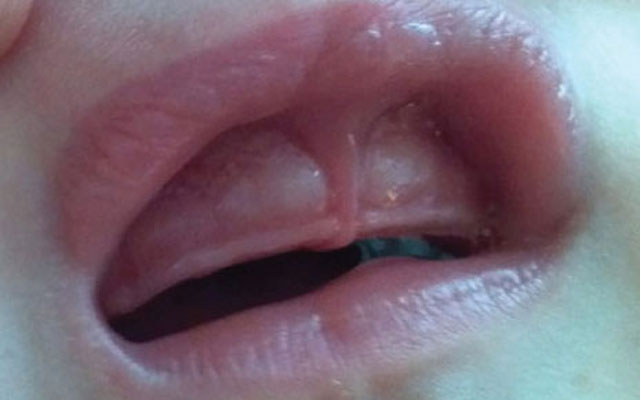 Perhaps the most important factor in successful breastfeeding is a baby’s ability to latch onto your breast and achieve a good seal. While this might seem an obvious conclusion and a straightforward action, in practice, not every baby will latch well at the outset. Sometimes establishing that first really good latch can be challenging. However, once this initial difficulty is overcome, it is easier to achieve a good latch and seal.
Perhaps the most important factor in successful breastfeeding is a baby’s ability to latch onto your breast and achieve a good seal. While this might seem an obvious conclusion and a straightforward action, in practice, not every baby will latch well at the outset. Sometimes establishing that first really good latch can be challenging. However, once this initial difficulty is overcome, it is easier to achieve a good latch and seal.
However, if a baby is born with abnormalities of the soft tissue in their mouth, breastfeeding may become challenging. One of the more commonly identified abnormalities is tongue-tie, however, another exists which can be equally detrimental to breastfeeding and often goes undiagnosed. This condition is called lip-tie.
What is a lip-tie?
Inside the human mouth, under the upper lip and roughly between the two front teeth is a piece of skin that connects to the upper gum. This piece of skin is called the labial frenulum. In some babies the labial frenulum is too short or thick and too tightly pinned to the upper gum, restricting the movement of the upper lip. When this occurs the baby is said to have a lip-tie. While in some cases a lip-tie might be minor and not pose any significant issue to breastfeeding, in other cases a lip-tie can make effective feeding almost impossible.
What are the degrees of lip tie?
The extent of a lip-tie is classified using four classes:
- In a Class I lip-tie the labial frenulum is just visible, does not extend down below the gum line and while there may be some minor restriction of movement this does not generally impact breastfeeding;
- With a Class II lip-tie the labial frenulum extends down beyond the gum line and appears to be inserted just between where the front teeth will erupt;
- For a Class III lip-tie the labial frenulum extends well down the gum into the area between where the front teeth will erupt;
- In a Class IV lip-tie, the labial frenulum extends down between the front teeth, wraps under and is attached to the hard palate, which is the hard surface you can feel if you place your thumb behind your front teeth.
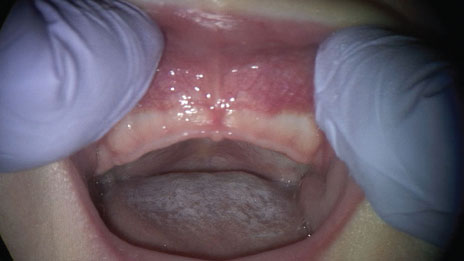
Class I Lip Tie
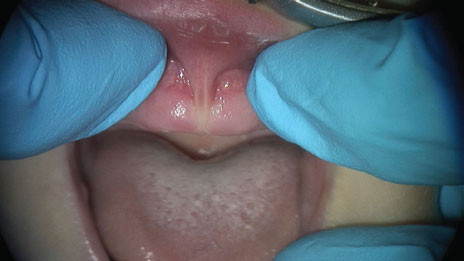
Lip II Lip Tie
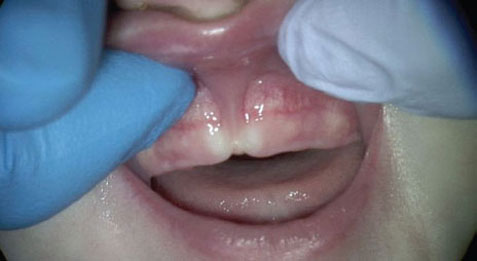
Class III Lip Tie
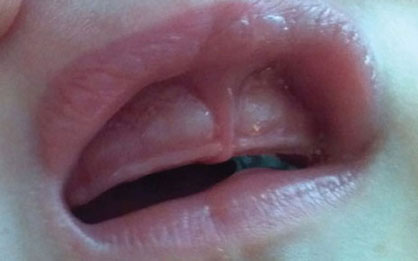
Class IV Lip Tie
How does lip-tie affect breastfeeding?
As we mentioned earlier, successful breastfeeding depends on a baby being able to establish a good latch and seal. This occurs when the baby opens its mouth wide, flairs its upper lip and is able to take both the areola and nipple into its mouth.
When a baby has a lip-tie, they are unable to flair their top lip out effectively and so may take only the nipple into their mouth. This causes pain for the mother and can result in nipple damage but also results in the baby being unable to effectively draw milk from the breast. The baby may seem to ‘slip off’ the breast or seem to refuse to open their mouth wide to latch.
How can we fix it?
Where a baby is healthy and developing well and the mother does not report significant discomfort in breastfeeding, she might decide not to have the lip-tie fixed. However where the baby is not gaining sufficient weight and/or the mother is experiencing pain or nipple damage during breastfeeding, releasing the lip-tie may be a good option. The risk in not doing so is that over time breastfeeding becomes so difficult, frustrating or painful that it results in a mother stopping breastfeeding early where she would otherwise have continued.
We can release a lip-tie by ‘snipping’ the labial frenulum to effectively free the top lip. It is a simple procedure, takes only a matter of seconds and professionals can perform it without anaesthetic. While there might be a little bleeding and discomfort, breastfeeding straight afterwards will distract and comfort your baby. Your breast milk will also act as an analgesic, relieving your baby’s discomfort. Alternatively, we can release a it by using a laser, which is less painful for the infant and also produces less scar tissue than ‘snipping’ the tie.
Does fixing a lip-tie improve breastfeeding?
From the first feed after releasing a lip-tie most women notice the difference in the way their baby breastfeeds. The first most obvious change is the amount of the breast the baby is able to take into their mouth but also where a mother has experienced pain, this first feed post-release may well seem like sweet relief. It generally takes two to three weeks for the full effect of the lip-tie release to occur. But over this time, mothers will generally report that their baby is more able to open their mouth wide and flair their top lip thus creating a better latch and seal than they achieved previously.
Written 13 March 2014
Images reproduced with permission by Lawrence A. Kotlow
References
Australian Breastfeeding Association. (2011). Tongue-tie and upper lip-tie. Retrieved from https://www.breastfeeding.asn.au/bf-info/tongue-tie (this page is no longer available)
Kotlow, L. (2012). Diagnosis and treatment of ankyloglossia and tied maxillary fraenum in infants using Er:YaG and 1064 diode lasers. European Archives of Paediatric Dentistry, 12(2), 106–112. doi:10.1007/BF03262789
Kotlow, L. A. (2013). Diagnosing and understanding the maxillary lip-tie (superior labial, the maxillary labial frenum) as it relates to breastfeeding. Journal of Human Lactation : Official Journal of International Lactation Consultant Association, 29(4), 458–64. doi:10.1177/0890334413491325


Recent Comments